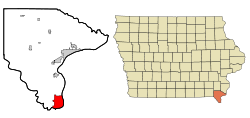Keokuk, Iowa | |
|---|---|
 Main Street (January 2009) | |
| Nickname(s): "The Gate City", "Power City", "Geode Capital of The World" | |
 Location within Lee County and Iowa | |
| Coordinates: 40°23′50″N 91°23′06″W / 40.39722°N 91.38500°W[1] | |
| Country | United States |
| State | Iowa |
| County | Lee |
| Founded | 1832 |
| Incorporated | December 13, 1848[2] |
| Government | |
| • Type | Mayor–council government |
| • Mayor | Kathie Mahoney |
| Area | |
| • Total | 10.55 sq mi (27.32 km2) |
| • Land | 9.10 sq mi (23.57 km2) |
| • Water | 1.45 sq mi (3.75 km2) |
| Elevation | 568 ft (173 m) |
| Population (2020) | |
| • Total | 9,900 |
| • Estimate (April 2022)[4] | 9,623 |
| • Density | 1,088/sq mi (420.08/km2) |
| Time zone | UTC−6 (Central (CST)) |
| • Summer (DST) | UTC−5 (CDT) |
| ZIP Code | 52632 |
| Area code | 319 |
| FIPS code | 19-40845 |
| GNIS feature ID | [1] |
| Website | cityofkeokuk |
Keokuk /ˈkiːəkʌk/ is a city in and a county seat of Lee County, Iowa, United States.[5] It is Iowa's southernmost city. The population was 9,900 at the time of the 2020 census.[6] The city is named after the Sauk chief Keokuk, who is recognized with a statue in Rand Park. It is in the extreme southeast corner of Iowa, where the Des Moines River meets the Mississippi. It is at the junction of U.S. Routes 61, 136 and 218. Just across the rivers are the towns of Hamilton and Warsaw, Illinois, and Alexandria, Missouri. Keokuk, along with the city of Fort Madison, is a principal city of the Fort Madison-Keokuk micropolitan area, which includes all of Lee County, Iowa, Hancock County, Illinois and Clark County, Missouri.
- ^ a b c U.S. Geological Survey Geographic Names Information System: Keokuk, Iowa
- ^ "Keokuk, Iowa". City-Data. Retrieved May 10, 2011.
- ^ "2020 U.S. Gazetteer Files". United States Census Bureau. Retrieved March 16, 2022.
- ^ "Census.gov".
- ^ "Find a County". National Association of Counties. Archived from the original on May 31, 2011. Retrieved June 7, 2011.
- ^ "2020 Census State Redistricting Data". census.gov. United states Census Bureau. Retrieved August 12, 2021.